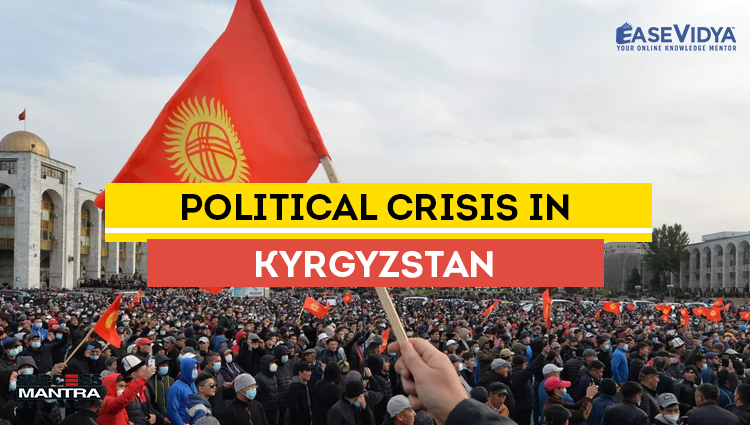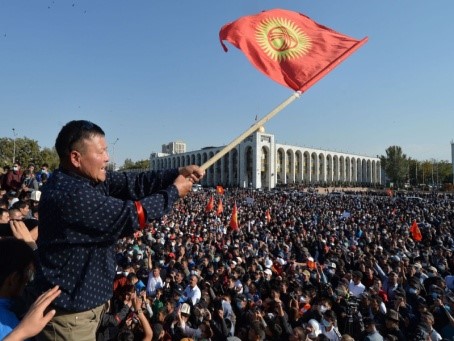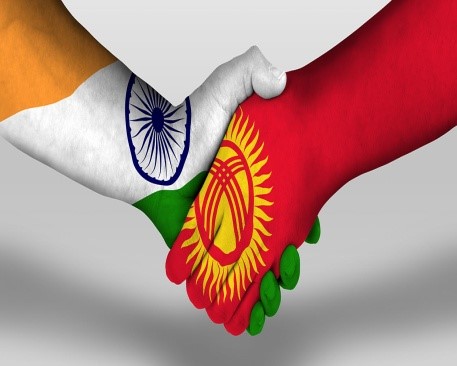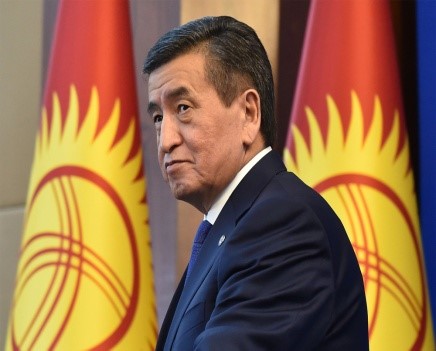
POLITICAL CRISIS IN KYRGYZSTAN
POLITICAL CRISIS IN KYRGYZSTAN

Over the past few days, Kyrgyzstan, the land-locked country that lies in Central Asia bordering China, has seen violent protests. Thousands of participants clashed with police forces in the country’s capital, Bishkek last week. Often referred to as the only democracy in the region, the country is witnessing one of its worst political crises in decades. On 9th October Kyrgyzstan president, Sooronbai Jeenbekov, who came to power in 2017 after winning a vote share of over 54 per cent, declared a state of emergency in the capital till October 21, giving permission to the military to step in after a fresh set of clashes broke out between supporters of rival politicians. Protesters in Kyrgyzstan have captured key government buildings, including the Parliament house and the presidential office and the situation is like a coup.
BACKGROUND OF THE PROTEST
Kyrgyzstan had faced two revolutions during the early 21st century, including the Tulip Revolution in 2005 and the Kyrgyz Revolution of 2010. In August 2020, Kyrgyz President Sooronbai Jeenbekov indicated that the parliamentary elections would not be postponed despite the coronavirus pandemic. During the elections, several parties were accused of buying votes. Several journalists also reported that they had been harassed or attacked. Out of the parties that made it into parliament, only United Kyrgyzstan consistently opposes the incumbent government led by Jeenbekov. Political analysts have tied the 2020 protests to a socio-economic divide between Kyrgyzstan's agrarian south and more-developed north. Of the initial election results, 100 of the 120 seats were filled by southerners who supported Jeenbekov. The current protests began after early results of the parliamentary election were announced. Political parties in Kyrgyzstan should win at least 7% of the popular vote to enter Parliament. The results showed that only four parties managed to cross the threshold and of which, three were pro-government parties. The only one opposition party could cross the threshold.
CAUSES OF THE PROTEST
Even before the election, political fault lines were sharpening in Kyrgyzstan. The country’s main political party, the Social Democratic Party of Kyrgyzstan (SDPK), stayed out of the election due to intra-party rift and split. Several political leaders were detained and elections were perceived as rigged. Consequently, after elections, protestors formed a Coordination Council to lead the “revolution”. The country’s Election Commission annulled the results, but the protesters continued.
• Official View: Opposition’s intention is to instigate a political coup.
• The Opposition’s View: The elections were rigged which made people protest against the establishment.
INDIA & KYRGYZSTAN BILATERAL TIES

India has enjoyed strong bilateral ties with Kyrgyzstan since 1991. India was one of the first countries to establish diplomatic ties with Kyrgyzstan in 1992. Since 1992, the two countries have many agreements, including on Culture, Trade and Economic Cooperation, Civil Aviation, Investment Promotion and Protection, Avoidance of Double Taxation, Consular Convention etc. In 2011, the joint ‘Khanjar’ series of exercises was started.
Indian Diaspora in Kyrgyzstan- about 9,000 Indian students are studying medicine in various medical institutions in the country. Strategic: The Kyrgyz leaderships have been largely supportive of India’s stand on Kashmir. They also support India’s bid for a permanent seat at the UNSC. Departure from a Democratic Regime may bring uncertainty for India’s interests
KYRGYZSTAN'S SIGNIFICANCE FOR OTHER COUNTRIES
Kyrgyzstan has been key to the strategic plans of both Russia and China. Russia considers the region as its backyard and plays hard politics to retain its influence. Kyrgyzstan is a member of the Russia-led Collective Security Treaty Organisation (CSTO). CSTO is a Russia-led military alliance of six former Soviet states that was created in 2002. Its aim is to ensure the collective defence of any member that faces external aggression.
Members of CSTO: Armenia, Belarus, Kazakhstan, Kyrgyzstan, Russian Federation and Tajikistan. While Russia has cultivated strong ties with all political factions in Kyrgyzstan, radical political changes could throw up opportunities for its rivals. Belarus, another country in Russia’s backyard with a pro-Russia President, is already witnessing political turmoil after August’s Presidential election. In the South Caucasus, the conflict between Armenia and Azerbaijan, both former Soviet Republics, over Nagorno-Karabakh, risks dragging Russia into a conflict that Russia doesn’t want. All three combined, Russia’s attempts to build stronger political and economic integration with the former Soviet region are suddenly facing critical challenges.
CHINA: This landlocked Central Asian country that shares a long border with China. It is located at the centre of Eurasia, is a vital link in its Belt and Road Initiative. In 2019, Chinese President visited Bishkek (capital) - shows close link with the current establishment. China has built road and rail networks with Kyrgyzstan and Uzbekistan.
UNITED STATES OF AMERICA: During the early stages of the Afghan war, the USA had used Kyrgyzstan for refuelling and other logistical purposes. The USA base was shut down in 2014 by Parliament. A regime change can be favourable for the USA.
RECENT SCENARIO IN KYRGYZSTAN

State of Emergency: Jeenbekov had introduced a state of emergency in the capital, Bishkek, which was endorsed by the parliament on October 13. The authorities had deployed troops to Bishkek over the weekend and introduced the curfew. The move eased tensions in the city, where residents feared looting that had accompanied the previous uprisings and began forming vigilante groups to protect property. Jeenbekov had also supported the appointment of Sadyr Zhaparov, a former lawmaker who was freed from jail by demonstrators last week, as the country’s new prime minister. He endorsed Zhaparov’s new Cabinet.
Resignation of President Sooronbay Jeenbekov: Kyrgyzstan President Sooronbay Jeenbekov stepped down from his position on October 15, 2020 to bring an end to the turmoil that has gripped the nation after the disputed parliamentary elections. In an official statement, Jeenbekov stated that holding on to power wasn't worth the integrity of the country and agreement in society. The decision came after intense calls from protestors and political opposition, demanding for Sooronbai Jeenbekov's resignation & the Kyrgyzstan was plunged into crisis after October 4 General Elections, which were swept by pro-government parties. The opposition criticized the elections, accusing the government of vote-buying and other irregularities. Following the election results, protestors took over government buildings and looted some offices. The Central Election Commission then nullified the election, following which the opposition planned to oust Jeenbekov and form a new government. Hundreds of protestors came together in Kyrgyzstan's capital city, Bishkek to demand for Jeenbekov's resignation.
QUESTION (1-5)
Q.1 Which of the following is the former President of Kyrgyzstan who resigned in October this year amidst the political Crisis in the country?
A. Almazbek Atambayev
B. Sooronbay Jeenbekov: ANSWER
C. Sadyr Zhaparov
D. Sapar Isakov
Q.2 Recently, Kyrgyzstan is facing a political turmoil in the capital city of which in result imposed the Emergency in the capital. Which of the following is the capital city of Kyrgyzstan?
A. Bishkek: ANSWER
B. Tashkent
C. Karakol
D. Astana
Q.3 Which of the following persons who had been recently freed from the jail and has been appointed as the Prime Minister of Kyrgyzstan?
A. Sooronbay Jeenbekov
B. Askar Akayev
C. Sadyr Zhaparov: ANSWER
D. Sapar Isakov
Q.4 Kyrgyzstan, a landlocked country in Central Asia is also one of the members of CSTO, which is headquartered in _________?
A. Moscow, Russia: ANSWER
B. Saint Petersburg, Russia
C. Bishkek, Kyrgyzstan
D. Astana, Kazakhstan
Q.5 India has shared strong bilateral & diplomatic ties with Kyrgyzstan. Which of the following joint exercises is conducted by these two countries?
A. Exercise Yudh Abhyas
B. Exercise Ajeya Warrior
C. Exercise Varuna
D. Exercise Khanjar: ANSWER












0 Comment